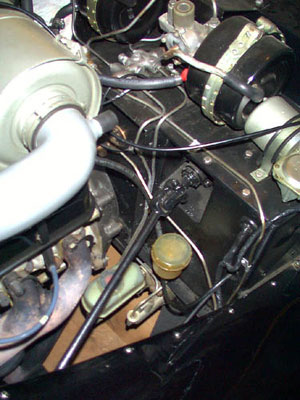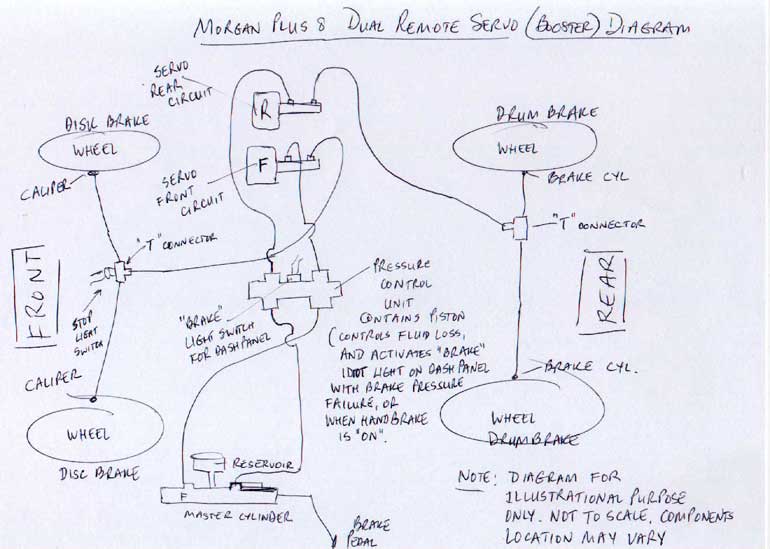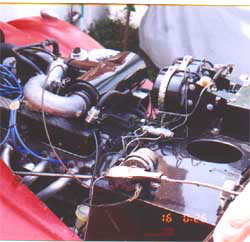
| WATCHPOINT: These early Girling servos are unrelated to the later POWERSTOP servos used on all Classic Morgans after June 1993. |
| WATCHPOINT: The early Girling servos were designed primarily for the American and European markets. They were fit standard for the US and Swiss markets. But for other markets, they were fit only by special request at an extra charge. For RHD cars, they simply copied the US installation on the right hand side of the car. |


The repair kit was available from LUCAS Girling, part# SP 26553, "Servo Kit". According to my Rover 3 litre -- the port nearest the vacuum cylinder (the big round drum) is the "fluid inlet port" and the port farthest from the vacuum cylinder is the "fluid outlet port". The 3 liter has the Girling MkII servo with the same hydraulic cylinder casting, but larger vacuum cylinder.
Incidentally, within the aluminum cast body are two cylinders: the upper one contains the "primary operating valve" and the lower one is the "slave cylinder". In other words, the upper piston responds to brake pedal (master cylinder) pressure and actuates the vacuum valve which causes the vacuum cylinder to put pressure on the slave cylinder. The pressure from the slave cylinder is the pressure transmitted to the wheel cylinders.
The diagram looks OK assuming that the two pipes going from the master cylinder to the servos are indeed going to the low pressure or input signal side of each servo. Also assuming that the two pipes shown leaving the master cylinder are both coming from high pressure ports on the master cylinder.
The Rover 2000 of 1968 to 1971 met the US Federal specifications requiring tandem brake circuits using a similar system. Where the original single circuit system had a single brake servo, the Federal models have two. The master cylinder also is, in effect, two master cylinders in one. There are four hydraulic ports on the master: two low pressure ports supplied by the reservoir and two ports that are pressurized by stepping on the pedal. I don't believe the Rover has a proportioning valve, but this function must have been accomplished with the two diffent master cylinder bore sizes and different size brake disks front and rear.
 Whereas
the Rover 2000 used Lockheed servos with rubber vacuum diaphrams, the
earlier
Rover P4 and P5 used Girling MkII servos similar those used on the Plus
8, MGC and Lotus Elan +2, except that the Rover used a larger vacuum
cylinder. The Girling servo used on the Rover, and maybe the
others, has a vacuum
piston instead of a diaphram, and if this piston sticks in the bore,
the
brakes will stay on and will be on more and more firmly each time the
pedal
is pushed.
Whereas
the Rover 2000 used Lockheed servos with rubber vacuum diaphrams, the
earlier
Rover P4 and P5 used Girling MkII servos similar those used on the Plus
8, MGC and Lotus Elan +2, except that the Rover used a larger vacuum
cylinder. The Girling servo used on the Rover, and maybe the
others, has a vacuum
piston instead of a diaphram, and if this piston sticks in the bore,
the
brakes will stay on and will be on more and more firmly each time the
pedal
is pushed.
Some rebuild kits contain parts that will lead to the piston sticking in the bore after the rebuild. There is a leather vacuum seal between the piston and the vacuum cylinder. This seal is forced against the bore by a foam rubber strip with round cross section that fits behind the seal. The seal is lubricated by a gray-black goop that may be graphite filled grease.
Some kits come without the black goop, and, worse, some kits come with a foam rubber strip that is too thick such that the leather seal is forced too tightly against the bore. (I learned all that after being faced with two tons of Rover 3 litre with the brakes locked firmly on in the middle of the street...)
Finally, Girling MkII servos have a valve body on the side of the hydraulic cylinders that releases the vacuum assist when pressure from the master cylinder is released. I suppose that if the two valves and the spring are not assembled right, it might not release the vacuum as it should.
N.B. You can unplug the vacuum connection and check with a stick or similar for brake fluid inside. Carefully not to punch a hole in the diaphragm.
Finally, if you need to rebuild the booster and can't obtain the rebuild kit from Mog sources, try Volvo specialists (early '70 Volvos had the same booster)